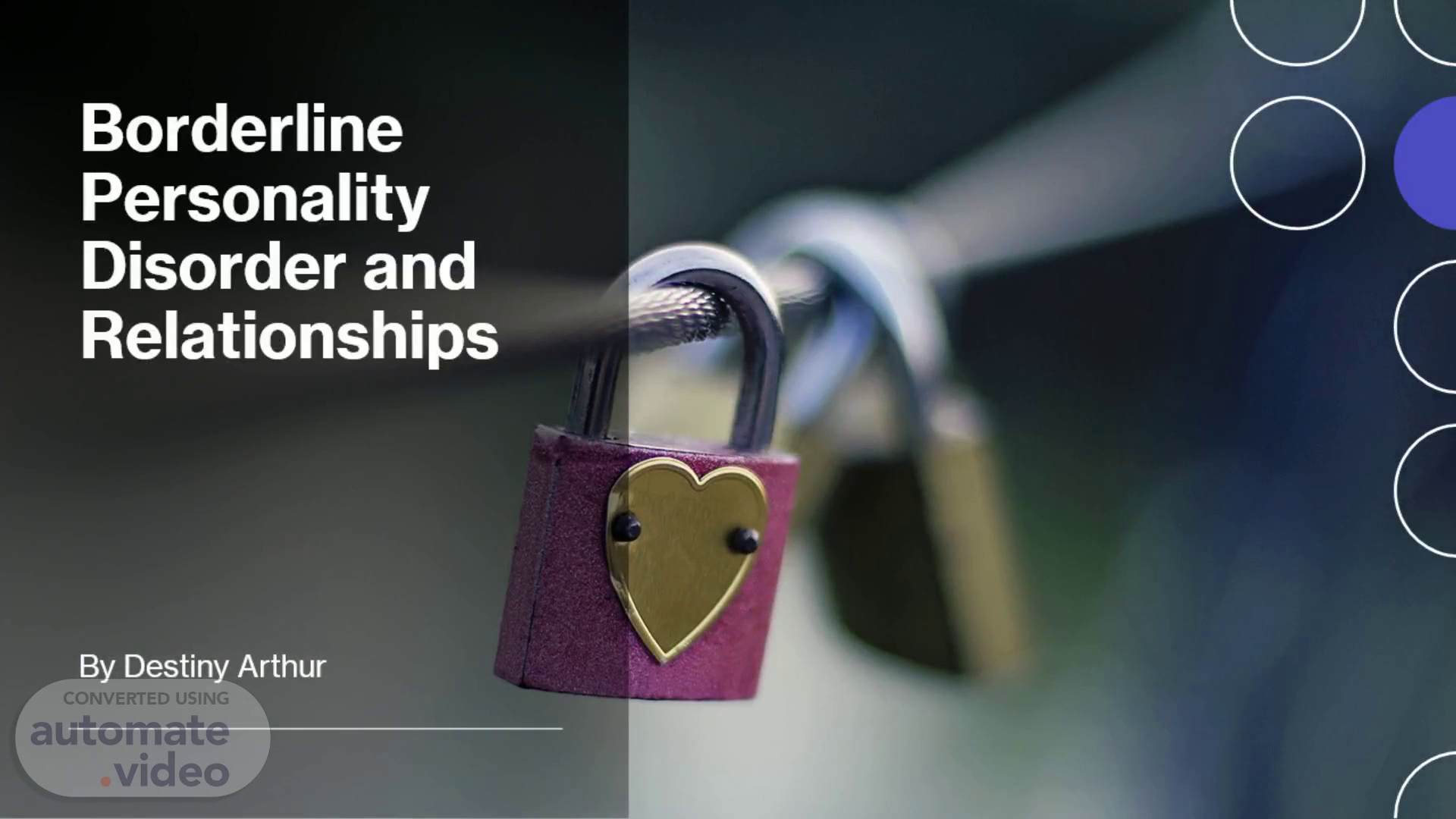
Borderline Personality Disorder and Relationships
Scene 1 (0s)
Audio Recording Nov 24, 2021 at 10:58:36 PM. Borderline Personality Disorder and Relationships.
Scene 2 (8s)
What is Borderline Personality Disorder?. Charaterized by Intensity and impulsivity Fears of abandonment Cognitve Distubrances Impulsive and Self- Damaging acts Dysfunctional Interpersonal Acts Ongoing feelings of emptiness.
Scene 3 (32s)
What Causes Borderline Personality Disorder? Borderline Personality Disorder may be linked to: Genetics Brain Ababnormaties (emotional regulation) Risk Factors: Hereditary Predispostion Stressful Childhood ( Borderline personality disorder 2019.
Scene 4 (52s)
Prevelance of Borderline Personality. A picture containing text Description automatically generated.
Scene 5 (1m 1s)
Idealiziton and Devaluation. What is Idealization? ''Idealization is a psychological or mental process of attributing overly positive qualities to another person or thing .'' (Kaplan & Sadock, 1989) ''Idealization reduces anxiety by protecting the person from emotional conflicts that might emerge in a relationship'' ( Perry et al., 2013) ).
Scene 6 (1m 18s)
Idealization and Devaluation. What is devaluation? ''In psychiatry and psychology, devaluation is a defense mechanism that is just the opposite of idealization.'' ''It's used when a person characterizes themselves, an object, or another person as completely flawed, worthless, or as having exaggerated negative qualities.'' (Perry et al., 2013).
Scene 7 (1m 35s)
Diagram Description automatically generated. (Kristalyn Salters-Pedneault, 2021).
Scene 8 (1m 42s)
Borderline Personality and Attachment. Attachment theory is liked with early childhood experiences Founded by Bowlby Attachment to caregivers and their reponse to the child Infants develop schemas Two studies found that found that BPD in general is significantly related to fearful avoidant and preoccupied attachment ( LEVY, 2005).
Scene 9 (1m 57s)
Diagram Description automatically generated. (Cho, 2020).
Scene 10 (2m 4s)
References. What is borderline personality disorder? Lifeskills Behavioral Health. (2020, October 6). Retrieved from https://www.lifeskillssouthflorida.com/mental-health-blog/what-is-borderline-personality-disorder/ . Gunderson JG. Disturbed relationships as a phenotype for borderline personality disorder. Am J Psychiatry. 2007 Nov;164(11):1637-40. doi : 10.1176/appi.ajp.2007.07071125. PMID: 17974925. Hill, J., Stepp, S. D., Wan, M. W., Hope, H., Morse, J. Q., Steele, M., Steele, H., & Pilkonis , P. A. (2011). Attachment, borderline personality, and romantic relationship dysfunction. Journal of personality disorders , 25 (6), 789–805. https://doi.org/10.1521/pedi.2011.25.6.789.
Scene 11 (2m 43s)
References Cont.. Kristalyn Salters-Pedneault, P. D. (2021, February 16). BPD splitting can harm relationships . Verywell Mind. Retrieved from https://www.verywellmind.com/what-is-splitting-425210 . Leduc-Cummings I, Starrs CJ, Perry JC. Idealization . In: Zeigler-Hill V, Shackelford TK, eds. Encyclopedia of Personality and Individual Differences. Springer International Publishing; 2020:2129-2132. doi:10.1007/978-3-319-24612-3_1385 LEVY, K. E. N. N. E. T. H. N. (2005). The implications of attachment theory and research for understanding borderline personality disorder. Development and Psychopathology , 17 (04). https://doi.org/10.1017/s0954579405050455 Mayo Foundation for Medical Education and Research. (2019, July 17). Borderline personality disorder . Mayo Clinic. Retrieved from https://www.mayoclinic.org/diseases-conditions/borderline-personality-disorder/symptoms-causes/syc-20370237 ..
Scene 12 (3m 27s)
Refrences Cont.. Perry JC, Presniak MD, Olson TR. Defense mechanisms in schizotypal, borderline, antisocial, and narcissistic personality disorders . Psychiatry . 2013;76(1):32-52. doi:10.1521/psyc.2013.76.1.32 Sadock BJ, Kaplan HI. Kaplan & Sadock's Synopsis of Psychiatry: Behavioral Sciences/Clinical Psychiatry . 10th edition . Philadelphia, PA: Lippincott Williams & Wilkins; 2007..